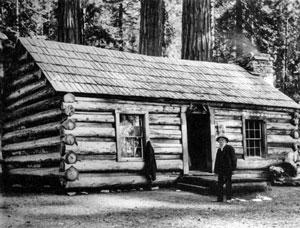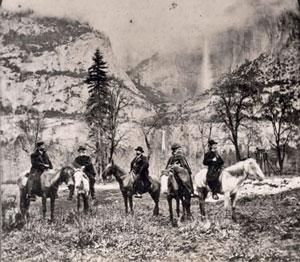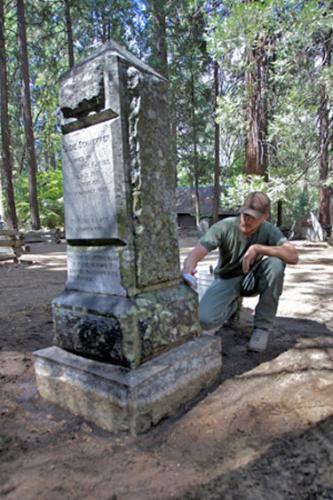Any cemetery contains links to our past, but one located in Yosemite National Park is especially rich in its connections to the early history of Yosemite. On March 3, a ceremony will celebrate three events: a restoration project for the old cemetery, and the birthdays of both a man and an event closely linked to the story of the park.
The ceremony, scheduled for 4 p.m. to 5 p.m. on Monday, will rededicate the historic cemetery, which has recently undergone badly needed restoration. The event will also mark the 200th birthday of Galen Clark, known as "the first Guardian of Yosemite Valley." Clark is one of several Yosemite pioneers buried in the cemetery.
Just for good measure, the special activities also coincide with the California State Parks Training Conference, 'The Heritage of Parks in California,' which is being held in Yosemite in honor of the 150th anniversary of the Yosemite Grant and the California State Parks.
"Something had to be done" for the cemetery
In the years since Galen Clark and others were laid to rest in the Yosemite Cemetery, time and the elements had taken a serious toll on the markers and monuments. A park spokesperson noted, "Gravestones were damaged and split. Metal fences were broken. Weathering and vegetation stains obscured the names and details of our past. Something had to be done."
The Yosemite Conservancy stepped up with a grant for stabilization and repairs. Among the work: scrubbing of 17 marble and granite monuments to remove staining, lichens, and mosses, refurbishing of wooden grave markers, and repairs to monuments and fences.
Monday's event will be held at the cemetery, which is located in Yosemite Valley across the street and just west of the Yosemite Museum. Special guests at the event are expected to include Lita Karlstrand, great-great-granddaughter of Galen Clark, and Jim Karlstrand, great-great-grandson-in-law of Galen Clark.
Clark's tombstone, a rustic boulder marked with only his name and dates, is a reminder that old grave markers can help tell many a tale of both tragedy... and triumph.
Galen Clark was among a group of tourists who entered Yosemite Valley in 1855, and the visit made a profound impact on his life. Clark's wife had died a few years earlier of "consumption," a much-feared disease that today we call tuberculosis. Clark was in his mid-40s when he was diagnosed with the malady, and he decided to spend his remaining days in the mountains near Yosemite.

Galen Clark in front of his cabin. NPS photo.
His "last remaining days" Were Productive
The climate and location were obviously good for him, since Galen Clark lived for another 50 years. He died just short of his 96th birthday, and made the most of the five decades of his "remaining days."
According to a park publication, "Galen Clark located and named the Mariposa Grove; worked for the creation of the Yosemite Grant, an act that that included the protection of the Mariposa Grove and Yosemite Valley; became the first guardian of the grant; guided many parties throughout his beloved big trees and valley; [and] wrote books about the Yosemite Grant, the big trees, and Indians of Yosemite."
John Muir called Clark the best mountaineer he ever met, and the two spent considerable time together roaming the mountains and forests of the area.
Clark's grave marker may be a simple one, but he left no doubt about his wishes for a final resting place. He reportedly "selected the site for and dug his own grave. He also chose the boulder for his headstone, had his name carved in it, and planted the giant sequoias that now surround his plot." You can read more about this colorful Yosemite pioneer here.
The "Father of Yosemite"?
Another early Yosemite settler memorialized in the old cemetery is James Mason Hutchings (1818-1902), whose large, uncut granite stone includes an inscription that sums up how his survivors viewed his contributions to Yosemite: "Father of Yosemite - Builder of the first trails, roads, bridges and dwellings of this valley."
Hutchings is indeed credited with a key role in opening the area to tourism. He also built a hotel in Yosemite Valley and published a magazine promoting the area as a travel destination.

James Hutchings with a group of tourists in Yosemite Valley. NPS photo.
One of those who made it possible for tourists to reach the Valley was stage driver John C. Anderson. Born in Sweden in 1812, Anderson was said to be a miner who arrived during the gold rush and later set up a land claim in Yosemite Valley. He became a guide and hostler, and the inscription on his marble marker tells us he "was killed by a horse on the 5th of July 1867" at the age of 55.
A Local Legend Grew from the Cemetery
John Anderson's story also confirms that cemeteries can be the birthplace of many a legend. According to local tradition, the stage driver's locust wood switch, stuck in the ground to mark his grave, sprouted... and the locust trees in the valley today are said to be its descendants.
Another Anderson with a place in Yosemite's history is also buried in the historic cemetery. George Anderson (1835-1884) was born in Scotland and, after time as a sailor and gold-seeker, settled in Yosemite Valley. He created a sensation when he completed the first known ascent of Half Dome on October 12, 1875. One report says Anderson laboriously drilled holes for spikes all the way up the back side of Half Dome and then attached a rope leading to the summit.
George Anderson's Rope Got Plenty of Use
Other Yosemite notables, including John Muir and Galen Clark, used George Anderson's rope for their own subsequent ascents of Half Dome until the rope was torn out by snows during the winter of 1884. Anderson's plans to construct a permanent stairway up Half Dome had failed to materialize, and few other people climbed the rock until the Sierra Club put up steel cables in 1919.
George Anderson also constructed the first school in the Valley in 1876, and built a trail along the north side of the Merced River and up to the cliff over which Vernal Fall drops. A small cedar log cabin which he built in 1876 is now part of the Pioneer Yosemite History Center at Wawona.

A group poses with the James Lamon monument in this undated photo. NPS photo.
One of the most imposing monuments in the Yosemite Cemetery marks the grave of James Lamon (1817-1875), said to be "the first permanent Euro-American settler of Yosemite." He recorded his claim to 160 acres of land in Yosemite Valley on May 17, 1861, built a sturdy log cabin and planted a garden and orchards.
A Man of a "Thousand Small Deeds"
Well-liked by others in the area, Lamon was described by John Muir as "... a fine, erect, whole-souled man, between six and seven feet high, with a broad open face, bland and guileless as his pet oxen . . . many there be, myself among the number, who can testify to his simple unostentatious kindness that found expression in a thousand small deeds."
Several people buried in the cemetery were involved in Yosemite's early years with the National Park Service. Forest S. Townsley (1882-1943) served as chief ranger at Yosemite for 27 years, beginning in 1916. A history of the park notes, "As Chief Park Ranger of Yosemite National Park, Townsley welcomed visitors from all parts of the world and from all stations in life and shared with them his love of the wilderness."
Among those Townsley escorted on camping trips in the park was Mrs. Eleanor Roosevelt, who later wrote, "He has the kindliest face I know and the most humor, yet the eyes look you so straight in the face that I should hate to meet him if I wished to hide anything. He gave you a sense of his strength.'
While a ranger at Platt National Park in about 1905, Townsley concluded that "a uniform should be designated for the ranger service," and developed "a good serviceable outfit for a mounted patrol ranger." After some later changes, this became the first National Park Ranger uniform.

Chief Ranger Forest Townsley is shown on the left in this photo taken in Yosemite in 1926. NPS photo.
Yosemite's Earliest Residents
The cemetery also reflects the earliest human heritage of the Valley, and a number of Native Americans are buried here. The NPS is consulting with tribes and tribal groups to learn of their desires for their gravesites.
Not everyone who was buried in this cemetery was a "Yosemite pioneer" or someone whose name is still well known today. Harry Eddy was a laborer working for the government road crew and a carpenter who worked on the Yosemite barn, and Sadie Schaeffer was a waitress at the Sentinel Hotel. George Fiske was a noted photographer who had a studio in the Valley, but little is known about Frank Bockerman, who walked into the park in 1910 looking for work, and died in the Army hospital.
An obituary for Colonel G. A. Madden (1853 ' 1897) says he was an English-born tourist from India, and died while a guest at the Sentinel Hotel. The "well-to-do tea merchant of Calcutta [was] on a tour around the world with his brother ....on their way to London to attend the jubilee of the queen."
Yosemite's Cemetery Sheltered Them All
Young or old, humble or wealthy, the Yosemite Cemetery sheltered them all. On May 24, 1875, a friend of James Lamon penned these words which help explain why this spot was a fitting resting place for some of those who helped lay the foundations for today's park:
"Friends and strangers joined in the procession which followed his remains to their final earthly rest. Under the branches of a gnarled old oak where the shadow of the cliffs that bound the great Yosemite cataract at evening spreads its sombre pall, we made a grave for our old friend Lamon. The gray domes, rugged cliffs, and cloud-wreathed spires of a temple grander than any reared by human hands, stand like grim sentinels to guard the walls of his burial ground, and the deep toned music of the surging fall thunders a requiem forever over the mortal remains of that noblest work of God, an honest man."


 Support Essential Coverage of Essential Places
Support Essential Coverage of Essential Places







Comments
Son of a gun. Three years in YOSE and I didn't even know there was a cemetery there!
Thanks, Jim, for an interesting read this morning.
I was just at the cemetery this past weekend and quickly noted the addition of wooden borders to the walkways through the grounds. A nice addition that defines the plots and keeps wanderers from tromping over the grave sites. Several of the tombstones and markers had been cleaned and overall this very important historical site was looking much better. A true hidden spot in the congested Yosemite Valley!
Lee, it's within a few dozen yards of away from the dispatch office where you spent much of your time. It's adjacent to the park administration building and the NPS employees housing area, across the street from the park's museum, Native American exhibit, staff offices, and library, etc. In 1969-71, I used to end my regularly scheduled guided ranger walks through Yosemite Valley, using the Pioneer History Cemetery as my final stop. I enjoyed showing the giant sequoia's growing around Galen Clark's grave, pointing out that although these trees were quite large, they were at the time only about 80 to 90 years old, having been planted by Galen Clark himself some decades before his death in 1910. This is one of the few places in Yosemite Valley to see giant sequoia cones without having to go indoors.
Linked from The Blaze so some of you might not to watch it. Your lose.
http://www.theblaze.com/stories/2014/03/02/spend-a-few-minutes-watching-...
Owen, I sort of remember the sequoias and a small area where Julia Parker would set up her basket making demonstrations -- but I just don't remember tombstones out there. Perhaps they were so covered with moss and stuff they weren't very noticeable.
Or could it be --- --- old age is slowly wiping out what is left of my memory?
A wonderful article, Jim. Thank you. You certainly brought back many memories of my four seasons in Yosemite Valley. As Owen Hoffman notes, the seasonal rangers used to lead walks through the cemetery; in the early 1980s, we did it at night with lanterns. We then interpreted the gravesites one by one, in effect, allowing the dead to speak. Visitors loved it and were deeply moved.
Congratulations to everyone concerned on this restoration. This is what all of us want from the Park Service, the cooperating associations, and friends of the parks in general. When those folks deliver it without our asking, we know they are on the ball. Thank you. This project really does everyone proud.
Thanks, Alfred.
This restoration effort was a great project, and the story was an interesting one to research.
The caption under the last photo is incorrect. It should say "Chief Ranger Forest Townsley..." John was Forest's son and he eventually became the Superintendent of Yellowstone.